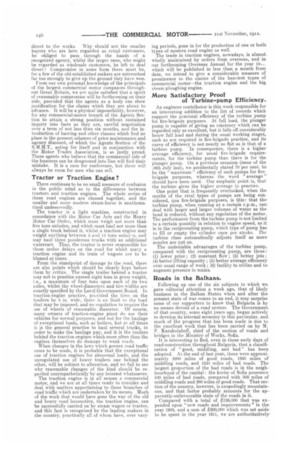Tractor or Traction Engine?
Page 2

If you've noticed an error in this article please click here to report it so we can fix it.
There continues to be no small measure of confusion in the public mind as to the differences between tractors and traction engines. The whole series of these road engines are classed together, and the smaller and more modern steam-horse is anathematized undeservedly.
The tractor is a light machine, constructed in accordance with the Motor Car Acts and the Heavy
Motor Car Order, which -must weigh not more than
five tons unladen, and which must. haul not more than a single truck behind it, whilst a traction engine may
weight anything between 3 and 14 tons unlad-n, and
may haul three ponderous trucks with an additional watercart. Thus, the tractor is never responsible for those undue delays on the road for which marey a traction engine and its train of wagons are to be blamed at times.
From the standpoint of damage to the road, there are also points which should be clearly kept. before them by critics. The single trailer behind a tractor may not in practice exceed eight tons in gross weight, i.e., a maximum of four tons upon each of its two axles, whilst the wheel-diameters and tire-widths are exactly specified by the Local Government, Board. In traction-engine practice, provided the tires on the trailers be 8 in. wide, there is no limit to the load that may be imposed, and no regulation to require the use of wheels of reasonable diameter. Of course, many owners of traction-engine plant do use their vehicles for normal purposes, and not for the haulage of exceptional loads, such as boilers, but at. all times it is the general practice to haul several trucks, in order to make the haulage pay, and it is the trailers behind the traction engines which more often than the engines themselves do damage to weak roads.
When changes in the laws which govern road traffic come to be made, it is probable that the exceptional use of traction engines for abnormal loads, and the unregulated use of heavy trailers one behind the other, will be subject to alteration, and we fail to see why reasonable changes of the kind should be regarded unsympathetically by any interest whatsoever. The traction engine is in all senses a commercial motor, and we are at all times ready to consider and deal with matters appertaining to those branches of road traffic which are undertaken by its means. Much of the work that would have gone the way of the old and heavy road locomotive, the traction engine, can be successfully carried on by steam wagon or tractor, and this fact is recognized by the leading makers in the country, practically all of whom have, over vary
ing periods, gone in for the production of one or both types of modern road engine as well. The trade in traction engines, nowadays, is almost. wholly maintained by orders from overseas, and in our forthcoming Overseas Annual for the year 191-, which will be published in less than a month from date, we intend to give a considerable measure of prominence to the claims of the heaviest types of commercial motor—the traction engine and the big steam-ploughing engine.






















